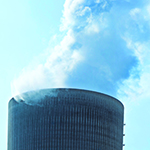 Tom Fitzpatrick, Power Department Manager, provides tips and recommendations for meeting national pollutant-emission standards published by the EPA in early 2013 in an article featured in HPAC Engineering Magazine.
Tom Fitzpatrick, Power Department Manager, provides tips and recommendations for meeting national pollutant-emission standards published by the EPA in early 2013 in an article featured in HPAC Engineering Magazine.
The deadlines are approaching for compliance with the U.S. Environmental Protection Agency’s (EPA) new national standards governing the emission of hazardous air pollutants (HAP) from industrial, commercial, and institutional boilers. Since most major source facilities whose emissions exceed the standard will need to make significant capital improvements or operational changes, decision makers need to weigh the “what ifs” that can impact their compliance strategy. Among these are the future cost of natural gas; the likelihood of new and/or more stringent emission limits; and the potential for increased operating costs associated with the use of coal and biomass.
Compliance strategies need to be carefully customized to address the specific emissions that need to be reduced and the power needs of the facility. For example, installing activated-carbon-injection (ACI) systems on units with baghouses is a viable solution when the boilers only need to reduce certain emissions. Tests are able to determine which type of activated carbon works best in the given situation. ACI systems that use bulk bag storage have the advantage of being significantly lower in cost than ones needing a storage silo. Urban campus facilities are another case in point where coal-fired boilers are being replaced with natural-gas-fired combined heat and power (CHP). Since these facilities are typically large users of electricity and already have a well-established steam-distribution system, installing CHP will improve overall energy efficiency.
Another common approach is to modify the operations in small coal-fired electricity-generating facilities so that the coal-fired boilers become limited-use units. Limited use boilers have a load factor of less than 10 percent, and are not subject to major-source emission limits. Although this allows owners to maintain generation capacity, it increases reliance on purchased power.
Tune-ups
When properly conducted, tune-ups will result in reduced fuel consumption and lower HAP emissions due to more efficient boiler operation. Planning in advance for a tune up is essential and should include gathering the unit’s original performance data, establishing procedures to be followed, and determining how to handle the excess steam and additional hours of operation that may be generated when the boilers are tested at full capacity.
When the tune-up is completed, the burners, flame patterns, control system, flue-gas-recirculation (FGR) system, fuel-atomization system, economizer, and air heaters will all have been inspected and working properly. CO emissions will be optimized.
Energy Assessments
Getting the optimum benefit from an energy assessment depends on the capabilities of the assessor and the range of the energy-saving opportunities he or she investigates. Among the recommendations proposed will be improving insulation; repairing steam and air leaks; installing variable-frequency drives, steam absorption chillers, and more efficient motors. The report should be very detailed in its outline of energy conservation measures (ECM) including capital costs, operational and energy savings, simple paybacks, and impact on operations.
Note that although the regulations do not require implementing the ECM’s, the report is likely to become part of public record which might cause the owner to feel obligated to implement some or all of the recommendations.
Converting from coal-fired boilers to natural gas
One of the primary advantages of converting from coal to natural gas is that it eliminates particulate, HCl, Hg, and sulfur dioxide emissions. At the same time, it reduces carbon-dioxide emissions and may lower NOx and CO emissions. Additionally, there is some indication that natural gas supply and pricing may continue to be favorable, making natural gas a cost effective fuel source. Despite these factors, converting to natural gas needs to be made on a case-by-case basis.
Owners need to consider the availability of natural gas based on the location of the facility. They should conduct an engineering study to determine if changes will be require to account for the difference in the combustion and heat transfer properties between coal and gas systems. The specific design of the existing coal-fired system and the type of boiler being converted will impact the modifications and associated costs of making this change. All factors underscore the need for careful study of the specific situation in order to arrive at the best solution.
To read the full article, click here.
